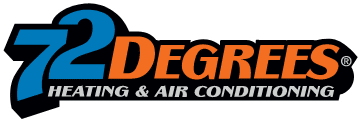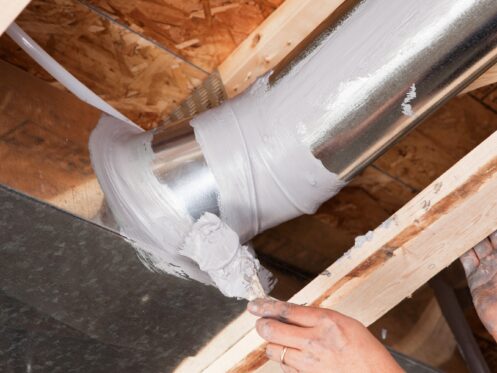Keeping your North Carolina home comfortable during the summer can get expensive due to how hard your central air conditioning system has to work. This is especially true for people who own older homes due to issues like air leaks, inefficient windows, and other common problems. Fortunately, you can take some simple steps to help improve your AC’s efficiency, allowing you to keep cool without breaking the bank.
1. Schedule an Annual Tune-Up
The single most important thing you can do to improve your cooling system’s performance and efficiency is to have an HVAC company inspect and service your air conditioning system each spring. Annual tune-ups help eliminate many common issues that can greatly decrease a cooling system’s performance.
Spring maintenance includes cleaning your cooling system’s internal components, such as coils and fan blades. A technician will also lubricate its moving parts to reduce friction and tighten electrical connections. Lack of maintenance can result in your central air conditioner being unable to remove as much heat from your house as it should, contributing to longer cooling cycles, decreased efficiency, and higher electricity bills.
In addition to improving efficiency, an annual tune-up also provides some other fantastic benefits. One is that it lowers the chances of your AC breaking down over the summer. A technician will inspect and test all of your system’s components, enabling them to find and fix any issues before they lead to major issues. An AC system that’s serviced every year will also typically require fewer repairs over its lifetime and have a longer life expectancy.
2. Don’t Forget to Pay Attention to Your Air Filter
Failing to replace the air filter in your HVAC system often enough will almost always lead to poor performance and reduced efficiency. Your filter prevents dust and debris from entering your cooling system and causing damage to its internal components. It also plays a critical role in maintaining indoor air quality by capturing airborne contaminants before they recirculate through your living spaces.
However, when your filter becomes clogged, it restricts airflow through your cooling system. This can cause a host of issues, including making it work harder to keep your home comfortable. It can also result in frozen coils and short cycling.
The standard rule is that air filters should be replaced every three months at the very least. However, this rule isn’t always applicable, as there are many situations when a filter may start clogging and restricting airflow sooner. For instance, you may need to replace the filter once a month during the hottest, most humid parts of the year. That’s because the more your HVAC system runs, the more debris the filter will trap, and the quicker it will get clogged.
If you have pets, a filter will also clog faster as a result of pet hair. These sorts of issues are why it’s a good idea to take the filter out and check how dirty it looks every couple of weeks. If the filter is coated with a layer of hair and debris, you know it is time for a fresh one.
3. Insulate Your Air Ducts
Insulating some of your air ducts can also lead to improved cooling efficiency and performance. The ducts in the main, conditioned areas of a house normally don’t need to be insulated, as they will always remain at around the same temperature as the air surrounding them. However, any ducts in an unconditioned space, like an attic or crawl space, should be insulated by a ductwork services expert.
Making sure the ducts in an attic are properly insulated is especially critical due to how hot an attic usually gets during the summer. Without adequate insulation, the cooled air will gain heat as it travels through the hot ducts in the attic. That means the air blowing out of the vents in the rooms those ducts supply won’t be nearly as cool as it should, resulting in slow cooling times and uneven cooling.
4. Use Your Ceiling Fans
In older homes, airflow often isn’t as balanced as it should be due to outdated ductwork, limited supply vents, or features that restrict circulation. Using your fans is a simple and affordable way to help compensate for these issues and improve your comfort during the summer months.
When set to spin counterclockwise, they push air downward and create a breeze that makes a room feel cooler than it actually is. This wind chill effect helps you feel more comfortable at slightly higher temperatures, which means you can raise the thermostat a few degrees without noticing a difference. That small adjustment takes some of the burden off your air conditioner and can lower your energy bills.
Ceiling fans are especially helpful in rooms that tend to feel warmer than the rest of the house, something that’s fairly common in older homes. By keeping air moving, they help distribute cool air more evenly and prevent hot spots.
5. Check for Drafts and Air Leaks
One of the main reasons that older homes tend to be less energy efficient and cost more to cool is that many of them have numerous air leaks. This is especially the case if the home still has any original windows or exterior doors. They also have additional places in the exterior structure where hot air from outside can get in.
Although fully reinsulating a home and sealing the entire exterior can be challenging and costly, you can still improve cooling efficiency by sealing leaks around your windows and doors or insulating crawlspaces and attics. Check that the caulking or sealant on the interior and exterior of the frames is still in good condition and not cracked or missing in places. If it is damaged, you can remove the old material and apply fresh caulk to close up any gaps where hot air might seep in. It’s also a good idea to inspect the weather stripping around doors and windows. Replacing worn or flattened strips helps create a tighter seal, reducing drafts and helping your air conditioner maintain a more consistent indoor temperature.
6. Reinsulate Your Attic Floor
Reinsulating the attic floor can significantly reduce heat transfer into your living spaces. Many older homes lack sufficient insulation. It may also have settled or deteriorated over time. When the insulation isn’t doing its job, heat from the attic can seep into the rooms below, forcing your air conditioner to run longer and work harder to maintain a comfortable temperature.
One common sign of poor attic insulation is that your home feels noticeably hotter in the late afternoon, especially on the upper floors. That’s because attics absorb and retain solar heat throughout the day, and without a well-insulated floor to slow the transfer, that heat radiates into your living areas as the attic temperature rises.
Contact Your Local Cooling Experts
Since 1988, 72 Degrees Heating & Air Conditioning has been the trusted choice for cooling and heating services in Apex and the Triangle area. Whether you need an AC tune-up, repairs, or an upgrade, you can count on us for reliable, high-quality service. Contact us today to ensure your AC operates efficiently this summer.


